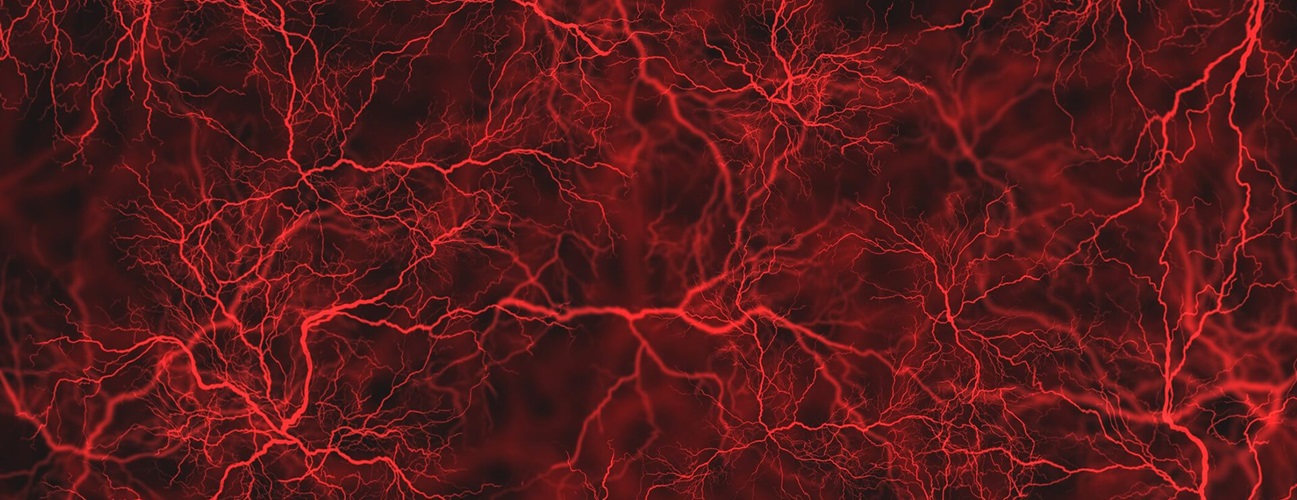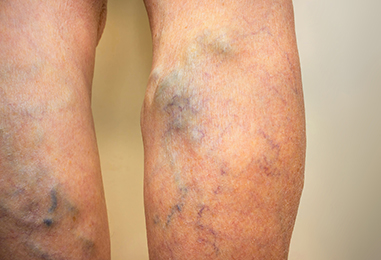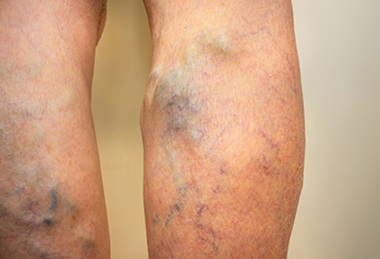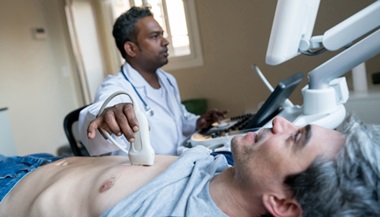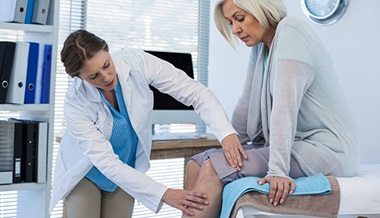Klippel-Trenaunay Syndrome (KTS)
Klippel-Trenaunay syndrome, also called KTS or KT syndrome, is a rare venous malformation disorder. KTS affects how blood and lymph vessels develop in a baby before birth. Klippel Trenaunay Weber syndrome is an older name for the condition.
What You Need to Know
- Klippel-Trenaunay syndrome causes malformations of blood and lymph vessels, skin “stains” (dark red or purple areas on the skin) and enlarged arms or legs.
- KTS vessel malformations develop before birth.
- Klippel-Trenaunay syndrome may cause complications such as blood clots, which can dislodge, travel to the lungs and cause a pulmonary embolism.
- KTS treatments vary, and are determined based on the individual patient. Some treatments involve medications and procedures that prevent blood clots. Other interventions include surgery and procedures to seal off vessels.
What is Klippel-Trenaunay syndrome?
A syndrome is a pattern of multiple signs and symptoms that occur together without a known cause. In people with Klippel-Trenaunay syndrome, malformations of blood and lymph vessels happen before birth, and may show up as birthmarks in babies.
Deeper malformations are not always apparent until childhood, and can appear as swollen areas that can enlarge in the face, arms, legs or elsewhere. These swollen areas can expand and press against facial features and internal organs.
Because these malformations slow down blood flow, there is a risk of infection or blood clots forming in them. Blood clots can travel to the lungs, and this condition, called a pulmonary embolism, can be life-threatening.
KTS can also affect the person’s bones and soft tissue. One arm or leg may grow larger than the other. People with Klippel-Trenaunay syndrome also may have enlarged or differently shaped fingers and toes.
What causes KT syndrome?
KTS may be the result of a change (mutation) to a gene that happens before the baby is born. KTS occurs mostly in people with no known family history of the syndrome, though it may run in families. Sometimes a mutation can create more than one set of cells with the same genes. This is a rare situation called a mosaic mutation.
KTS Symptoms
Klippel-Trenaunay syndrome affects blood vessels before birth as the baby is developing. Three things define Klippel-Trenaunay syndrome:
- Capillary malformations (skin “stains”)
- Venous malformations such as dilated, tangled or enlarged varicose veins. The lymph vessels in that area may or may not be malformed as well. These can occur close to the skin surface or deep within the body.
- Overgrowth of an arm or leg due to enlarged vessels, bones or soft tissue.
KTS Skin Stains
Skin stains such as port-wine stains are pink, dark red or purple birthmarks on the skin. They are caused by capillary malformations just below the skin’s surface. While they are a symptom of KTS, port-wine stains and other skin stains can occur in people without Klippel-Trenaunay syndrome.
In people with KTS, when lymph vessels are involved, skin stains may be geographic, meaning they are dark red or purple and have sharp, clear borders. In contrast, segmental stains appear more blotch-like with less distinct margins and a lighter color. Segmental stains indicate that lymph vessels are not part of the vascular deformity.
KTS Vein and Lymph Vessel Malformations
Venous malformations associated with Klippel-Trenaunay syndrome may show up on ultrasound before the baby is born. Others may be observed in the newborn. Still other VMs may not be noticed at birth, but may become more obvious as a child grows.
VMs may appear as enlarged veins or soft, bluish, swollen areas under the skin of the thighs. The vessels’ valves, which help fluids move in one direction, may be missing or malformed, so they do not work well to keep blood or lymph from backing up in the vessel. This can result in infections and sores (ulcers).
Venous malformations can also affect veins deep inside the leg. The wall of a vein in the leg can become tough and fibrous. Aneurysms, or bulging, thin areas of a blood vessel, can form. These problems may not be visible on the outside, and may only be detected by an MRI or ultrasound imaging.
Lymph vessels may also be malformed and cause masses on the skin called lymphangiectasia. These lesions can grow large, and they may have a pebbled appearance due to blister-like lesions called blebs, which can be flesh-colored, red or purple. Blebs can leak blood and lymph and become infected. Lymph vessel malformations can affect the genital area or develop deep in the body, where they can push aside internal organs in the abdomen.
Limb Enlargement
A baby born with KTS may have one arm or leg larger than the other. A vein or lymph vessel enlargement can make an arm or leg thicker, and overgrowth of the bones and soft tissue also can lengthen the limb. In some cases, the bone and soft tissue enlargement is progressive ― it continues as the child grows ― but usually it stops when the child reaches adolescence.
Limb enlargement can cause significant problems. Having one leg much larger than the other can cause the spine to twist and the pelvis to tilt out of alignment as the child grows, resulting in scoliosis. Over time, scoliosis can cause chronic pain and difficulty with walking and mobility.
Hand and Foot Malformations
Klippel-Trenaunay syndrome can affect the hands and feet. A child may have missing or extra fingers or toes. One or more of the fingers or toes may be abnormally curved, or much larger or smaller than the others. Two or more fingers or toes may be fused together.
KTS Diagnosis
Signs of KTS may show up on ultrasound before the baby is born, but not always. If Klippel-Trenaunay syndrome is suspected in a child, several tests can help identify the disorder and assess its impact on blood vessels, bones, blood and soft tissue:
- MRI and magnetic resonance angiography (MRA) use magnets and computers to see soft tissues and blood vessels. An MRI may be used with contrast media, a liquid that is injected into the blood vessels that then shows up on the image and can capture details of vessels and blood and lymph flow.
- Ultrasound and other vascular studies can help doctors see irregular veins and how blood and lymph are flowing in and out of malformed areas. Most important, Doppler or duplex ultrasound can spot blood clots or blockages in the bloodstream.
- X-rays can examine enlarged limbs and see if the enlargement involves the bone.
- A special kind of X-ray called a venogram, conducted by a radiologist who injects the veins with dye, can show malformed vessels both close to the skin surface and deep in the body.
- Blood tests can identify problems with blood clotting. The tests may be repeated throughout the person’s lifetime, especially during pregnancy and before surgery or a medical procedure.
- Biopsy is seldom needed to diagnose Klippel-Trenaunay syndrome, but taking a small tissue sample from the area and examining it for genetic mutations may be recommended in some cases.
Differential Diagnosis: Is it KTS or something else?
Some of the signs and symptoms of Klippel-Trenaunay syndrome are like those of other conditions. A differential diagnosis is when the doctor uses data and results from tests to confirm or rule out similar disorders.
For example, a condition called diffuse capillary malformation with overgrowth (DCMO) is like KTS but with milder symptoms. Once regarded as a mild form of Klippel-Trenaunay syndrome, DCMO more recently has been found to be a separate syndrome associated with a different gene mutation.
Another condition, Parkes Weber syndrome, is characterized by the malformation of capillaries (tiny blood vessels where veins and arteries exchange oxygen and carbon dioxide) and abnormal openings (fistulas) between veins and arteries.
Other conditions associated with genetic mutations that feature vascular malformations or limb overgrowth may have signs and symptoms that overlap with those of Klippel-Trenaunay syndrome. These include:
- Servelle-Martorell syndrome
- Macrocephaly-capillary malformation
- CLOVES syndrome
- Proteus syndrome
Our Approach to Treating Vascular Anomalies
Klippel-Trenaunay Syndrome Complications
Typically, life expectancy for people with KTS is normal, but much depends on the severity of the syndrome and avoiding complications, some of which can be life-threatening.
Blood Clots and Pulmonary Embolisms
Because the vessel malformations in KTS slow down blood flow, a person with this disorder has a higher risk of blood clots, which can be life-threatening. For example, in deep vein thrombosis, a blood clot can block blood flow in the leg or travel to the lung (pulmonary embolism). Blood clots and pulmonary embolisms are the most serious complications of KTS.
Bleeding
Irregular blood vessels may bleed, including small veins close to the surface of the skin and larger vessels deep in the body.
Infections
When blood or lymphatic fluid slows down and pools in vascular malformations, infections can develop, leading to cellulitis, skin breakdown, ulcers and sepsis.
KTS Treatment
Doctors treating children with KTS focus on preventing infections, helping the child achieve and maintain mobility, and addressing pain and other symptoms. There is no specific treatment that resolves KTS.
Treatment for Klippel-Trenaunay syndrome may involve doctors from several specialties. A person with KTS may need to see experts in vascular anomalies, radiology, plastic surgery, orthopaedics, hematology and other specialties. Physical therapists and occupational therapists can work with patients who have disabilities due to limb enlargement.
KTS treatment may involve several treatment approaches:
Medications
- mTOR inhibitor drugs such as sirolimus and alpelisib may slow down the progression of vascular malformations and address pain and other symptoms.
- Blood-thinning medications (anticoagulants) such as low-dose aspirin may be prescribed to prevent blood clots.
Other Approaches
- Physical therapy and occupational therapy can help people with uneven limbs maximize mobility and independence.
- Compression garments may help blood flow and prevent blood and lymph pooling in the legs and feet.
- Corrective footwear inserts can make it easier for a person with uneven legs to walk.
Surgery and Other Procedures for Klippel-Trenaunay Syndrome
Surgery may be able to address uneven limb length or vein malformations. Surgeries for KTS may include:
- Surgical removal of venous malformations where possible, to address bleeding, sores, lymphatic fluid leaks, organ compression in the pelvis or repeated infections
- Debulking procedures to remove severe overgrowth of soft tissue that prevents movement
- Amputation to remove oversized toes if they prevent the patient from walking or wearing shoes, with additional amputation possible if KTS is causing severe bleeding, blood clots or infections in the foot or lower legs
- Thermal ablation uses heat to seal veins and lymph vessels that are flowing into malformations.
- Laser therapy applied by a dermatologist to reduce the appearance of skin stains
- Sclerotherapy to seal off vessels that are draining into a vessel malformation. In this procedure, doctors use image-guided needles to inject medicine into the vessels that create scar tissue and block flow.
Outlook for People with KTS
Although Klippel-Trenaunay syndrome cannot yet be eradicated, symptoms can be managed. A continuing relationship with an experienced medical team can help a person with KTS minimize discomfort and avoid complications.

